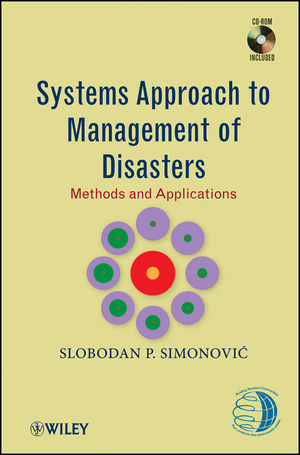Systems Approach to Management of Disasters: Methods and ApplicationsISBN: 978-0-470-52809-9
Hardcover
348 pages
December 2010
 This is a Print-on-Demand title. It will be printed specifically to fill your order. Please allow an additional 15-20 days delivery time. The book is not returnable.
|
||||||
List of Figures and Tables xiii
About the Author xix
Foreword xxi
Preface xxv
List of Acronyms and Abbreviations xxxiii
I Management of Disasters 1
1 Introduction 3
1.1 Issues in Management of Disasters—Personal Experience 6
1.1.1 Red River Flooding 6
1.1.2 “Red River Flood of the Century,” Manitoba, Canada 9
1.2 Tools for Management of Disasters—Two New Paradigms 19
1.2.1 The Complexity Paradigm 21
1.2.2 The Uncertainty Paradigm 24
1.3 Conclusions 26
References 27
Exercises 29
2 Integrated Disaster Management 30
2.1 Definition 30
2.2 Integrated Disaster Management Activities 31
2.2.1 Mitigation 31
2.2.2 Preparedness 39
2.2.3 Response 40
2.2.4 Recovery 40
2.3 Disaster Management in Canada—Brief Overview 41
2.3.1 Emergency Management Act 42
2.3.2 National Disaster Mitigation Strategy 42
2.3.3 Joint Emergency Preparedness Program 43
2.3.4 Emergency Response 44
2.3.5 The Role of Federal Government in Disaster Recovery 45
2.4 Decision Making and Integrated Disaster Management 46
2.4.1 Individual Decision Making 47
2.4.2 Decision Making in Organizations 47
2.4.3 Decision Making in Government 47
2.5 Systems View of Integrated Disaster Management 48
References 49
Exercises 50
II Systems Analysis for Integrated Management of Disasters 51
3 Systems Thinking and Integrated Disaster Management 53
3.1 System Definitions 54
3.1.1 What is a System? 55
3.1.2 Systems Thinking 56
3.1.3 Systems Analysis 59
3.1.4 The Systems Approach 60
3.1.5 Systems “Engineering” 60
3.1.6 Feedback 61
3.1.7 Mathematical Modeling 66
3.1.8 A Classification of Systems 68
3.1.9 A Classification of Mathematical Models 70
3.2 Systems View of Integrated Disaster Management 70
3.2.1 A Systems Typology in Integrated Disaster Management 71
3.2.2 Systems View of Disaster Management 73
3.2.3 Systems View of Disaster Management Activities 76
3.3 System Formulation Examples 77
3.3.1 Dynamics of Epidemics 78
3.3.2 Shortest Supply Route 80
3.3.3 Resources Allocation 81
References 82
Exercises 83
4 Introduction to Methods and Tools for a Systems Approach to Management of Disaster 85
4.1 Simulation 85
4.2 System Dynamics Simulation 89
4.3 Optimization 92
4.4 Multiobjective Analysis 95
4.5 Disaster Risk Management 97
4.5.1 Sources of Uncertainty 98
4.5.2 Conceptual Risk Definitions 100
4.5.3 Probabilistic Approach 102
4.5.4 A Fuzzy Set Approach 103
4.6 Computer Support: Decision Support Systems 106
References 109
Exercises 111
III Implementation of Systems Analysis to Management of Disasters 113
5 Simulation 115
5.1 Definitions 115
5.2 System Dynamics Simulation 116
5.2.1 Introduction 116
5.2.2 System Structure and Patterns of Behavior 117
5.3 System Dynamics Simulation Modeling Process 126
5.3.1 Causal Loop Diagram 127
5.3.2 Stock and Flow Diagram 131
5.3.3 Generic Principles of System Dynamics Simulation Modeling 133
5.3.4 Numerical Simulation 137
5.3.5 Policy Design and Evaluation—Model Use 141
5.4 System Dynamics Simulation Modeling Examples 141
5.4.1 A Simple Flu Epidemic Model 142
5.4.2 A More Complex Flu Epidemic Model with Recovery 146
5.5 An Example of Disaster Management Simulation—Flood Evacuation Simulation Model 152
5.5.1 Introduction 152
5.5.2 Human Behavior During Disasters 153
5.5.3 A System Dynamics Simulation Model 154
5.5.4 Application of the Evacuation Model to the Analyses of Flood Emergency Procedures in the Red River Basin, Manitoba, Canada 162
5.5.5 Conclusions 171
References 172
Exercises 172
6 Optimization 175
6.1 Linear Programming 178
6.1.1 Formulation of Linear Optimization Models 178
6.1.2 Algebraic Representations of Linear Optimization Models 182
6.2 The Simplex Method for Solving Linear Programs 186
6.2.1 Completeness of the Simplex Algorithm 190
6.2.2 The Big M Method 193
6.3 Duality in LP 196
6.3.1 Sensitivity Analysis 198
6.4 Special Types of LP Problems—Transportation Problem 202
6.4.1 Formulation of the Transportation Problem 202
6.4.2 Solution of the Transportation Problem 207
6.5 Special Types of LP Problems—Network Problems 213
6.5.1 The Shortest Path Problem 217
6.5.2 The Minimum Spanning Tree Problem 219
6.5.3 The Maximum Flow Problem 223
6.6 An Example of Disaster Management Optimization—The Optimal Placement of Casualty Evacuation Assets 229
6.6.1 Introduction 229
6.6.2 The OPTEVAC Model 230
6.6.3 A Casualty Evacuation Example 231
6.6.4 Summary 234
References 234
Exercises 235
7 Multiobjective Analysis 242
7.1 Introduction 243
7.1.1 Toward Operational Framework for Multiobjective Analysis 243
7.1.2 An Illustrative Example 244
7.2 Multiobjective Analysis Methodology 249
7.2.1 Change of Concept 251
7.2.2 Nondominated Solutions 251
7.2.3 Participation of Decision Makers 254
7.2.4 Classification of Multiobjective Techniques 255
7.2.5 Disaster Management Applications 259
7.3 The Weighting Method 263
7.4 The Compromise Programming Method 268
7.4.1 Compromise Programming 268
7.4.2 Some Practical Recommendations 273
7.4.3 The COMPRO Computer Program 273
7.5 An Example of Disaster Management Multiobjective Analysis—Selection of Flood Management Alternative 274
7.5.1 Preparation of Input Data 274
7.5.2 Solution of Flood Management Problem Using Compromise Programming 275
7.5.3 Summary 279
References 279
Exercises 281
IV Be Prepared 285
8 A View Ahead 287
8.1 Issues in Future Disaster Management 289
8.1.1 Climate Change 289
8.1.2 Population Growth and Migrations 291
8.2 A Systems View 292
References 293
Index 295



